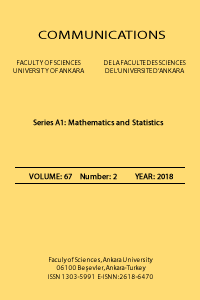A new perspective on bicomplex numbers with Leonardo number components
A new perspective on bicomplex numbers with Leonardo number components
Fibonacci numbers, bicomplex numbers, Leonardo numbers,
___
- Alp, Y., Koçer, E. G., Some properties of Leonardo numbers, Konuralp J. Math., 9(1) (2021), 183–189.
- Alp, Y., Koçer, E. G., Hybrid Leonardo numbers, Chaos, Solitons and Fractals, 150 (2021), 111–128. https://doi.org/10.1016/j.chaos.2021.111128
- Alves, F. R. V., Catarino, P. M. M. C., A forma matricial dos n´umeros de Leonardo, Ciencia e natura, 42 (2020), 1–6. https://doi.org/10.5902/2179460X41839
- Catarino, P., Borges, A., On Leonardo numbers, Acta Mathematica Universitatis Comenianae, 89(1) (2019), 75–86.
- Catarino, P., Borges, A., A note on incomplete Leonardo numbers, Integers, 20(7) (2020).
- Halıcı, S., On bicomplex Fibonacci numbers and their generalization, In Models and Theories in Social Systems, (2019), 509–524. https://doi.org/10.1007/978-3-030-00084-426
- Hamilton, W. R., Lectures on Quaternions, Hodges and Smith, Dublin, 1853.
- Hoggatt, V. E., Fibonacci and Lucas Numbers, A publication of the Fibonacci Association University of Santa Clara, Santa Clara, Houghton Mifflin Company, 1969.
- Horadam, A. F., Basic properties of a certain generalized sequence of numbers, Fibonacci Quarterly 3 (1965), 161–176.
- Kızılates C, Kone T. On higher order Fibonacci hyper complex numbers, Chaos Solitons Fractals, 148 (2021), 111044. https://doi.org/10.1016/j.chaos.2021.111044
- Koshy, T., Fibonacci and Lucas Numbers with Applications, John Wiley and Sons, Hoboken, NJ, USA, 2019.
- Kuruz, F., Dagdeviren, A., Catarino, P., On Leonardo Pisano hybrinomials, Mathematics, 9(22) (2021), 2923. https:/doi.org/10.3390/math9222923
- Luna-Elizarraras, M. E., Shapiro, M., Struppa, D. C., Bicomplex numbers and their elementary functions, Cubo 14 (2012), 61–80.
- Nurkan, S. K., Guven, I. A., A Note on bicomplex Fibonacci and Lucas numbers, International Journal of Pure and Applied Mathematics, 120(3) (2018), 365–377. https:/doi.org/10.12732/ijpam.v120i3.7
- Price, G. B., An Introduction to Multicomplex Spaces and Functions, Monographs and Textbooks in Pure and Applied Mathematics, M. Dekker, New York, NY, USA, 1991.
- Rochon, D., Shapiro, M., On algebraic properties of bicomplex and hyperbolic numbers, Anal. Univ. Oradea Fasc. Math., 11 (2004), 71–110.
- Segre, C., The real representation of complex elements and hyperalgebraic entities (Italian), Math. Ann., 40 (1892), 413–467.
- Shannon, A. G., A note on generalized Leonardo numbers, Notes Number Theory Discrete Math., 25(3) (2019), 97–101. https:/doi.org/10.7546/nntdm.2019.25.3.97-101.
- Sloane, N. J. A., The On-line Encyclopedia of Integers Sequences. 1964.
- Tan, E., Leung H. H., On Leonardo p-numbers, Integers, 23 (2023), 1-11. DOI: 10.5281/zenodo.7569221
- Torunbalcı, A., Bicomplex Fibonacci quaternions, Chaos, Solitons and Fractals, 106 (2018), 147–153. https://doi.org/10.1016/j.chaos.2017.11.026
- Vajda, S., Fibonacci and Lucas Numbers and The Golden Section, Ellis Horwood Limited Publ., England, 1989.
- ISSN: 1303-5991
- Yayın Aralığı: Yılda 4 Sayı
- Başlangıç: 1948
- Yayıncı: Ankara Üniversitesi
Timelike rotational hypersurfaces with timelike axis in Minkowski four-space
A new perspective on bicomplex numbers with Leonardo number components
Murat TURAN, Sıddıka ÖZKALDI KARAKUŞ, Semra KAYA NURKAN
Notes on some properties of the natural Riemann extension
Upper bounds for the blow up time for the Kirchhoff- type equation
